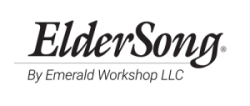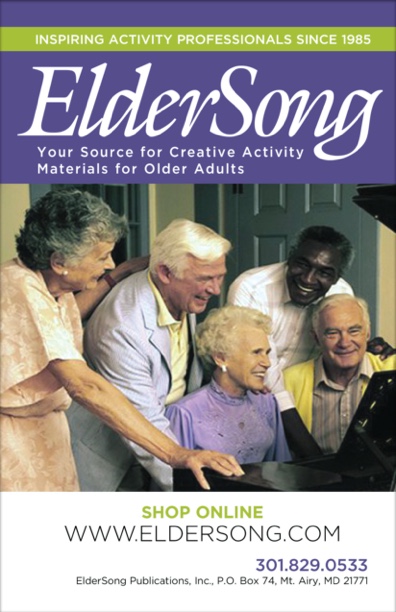Have you noticed today’s nostalgic craze for the 1950s? Ask your participants what images come to mind when they think of the years 1950-1959. Did they name tail-finned cars, interstate highways, crew cuts, hula hoops, PTA, poodle skirts, rock ‘n roll, fast food, or mothers in aprons?
In the 1950s, many of today’s older adults were newlyweds or parents of young children. The post-war baby boom was well underway, along with an explosion of new houses in the suburbs. Single-family homes furnished with new appliances and televisions became the norm. Chain supermarkets and shopping malls dotted the landscape. Increased prosperity spurred a wave of consumerism. The institutions of home, church, and community were an important part of the family-oriented Fifties.
Here are some activities to get your group started:
- Listen to Frank Sinatra sing “Love and Marriage.” Talk about American home life in the 50s. Was the decade all about marriage, family, and children? Housekeeping and raising a family was the ideal female role. Were men just wage earners? What did the media say about gender roles? What visions of family life were portrayed in TV sitcoms such as Leave It to Beaver and Father Knows Best?
- How was conformity to standards of behavior and dress encouraged? For insight into good manners and the social graces of the day, read some questions from Amy Vanderbilt’s Everyday Etiquette, published in the 1950s. Ask participants to comment on questions such as: Can a girl telephone a boy for a date? Should a woman put on makeup in public? How do you get the attention of a waiter in a restaurant? Have etiquette rules changed?
- The American way of life in the Fifties centered on domesticity. The “happy homemaker” relished her time-saving appliances and convenience foods. Ask your group about the introduction of frozen TV dinners, sugar-coated cereals, Minute Rice, and fish sticks. Pass around period cookbooks and women’s magazines such as Ladies’ Home Journal and Good Housekeeping. Did anyone try recipes from Betty Crocker’s Picture Cook Book? Ask the men to talk about building an outdoor barbecue for entertaining. Did any of them use ideas from Better Homes and Gardens Handyman’s Book? What other kinds of do-it-yourself home improvement projects did they attempt? How did the ladies decorate their ranch-style homes and cultivate a beautiful flower garden? Invite a Tupperware dealer to talk about 1950s Tupperware Home Parties. Bring in vintage pieces of the popular plastic ware and share some coffee and conversation.
- For a touch of 1950s humor, read essays from Jean Kerr’s 1957 bestseller Please Don’t Eat the Daisies, on domestic life in suburbia. Or, read excerpts from the 1957 bestseller Art Linkletter’s Kids Say the Darndest Things! The book was based on the TV series “Art Linkletter’s House Party Show,” which ran from 1952-1969.
To gain an appreciation for the decade of the Fifties, it’s important to begin with a review of the post-war period. In 1945, Harry S. Truman, a “simple man from Missouri,” became the 33rd president of the United States. Truman’s foreign and domestic policies had a profound impact on our nation and the world. Important news events during his administration included the end of World War II and the dropping of the atomic bomb, “Truman Doctrine,” Marshall Plan and NATO, Korean War, the Cold War, and civil rights. Encourage participants to talk about Truman’s resiliency, courage, and common sense as the leader of our nation from 1945 – 1952. Contrast Truman’s leadership style with Eisenhower’s. Ike served as president from 1953 – 1961.
Name some familiar objects from the decade: Barbie doll, TV Guide, Peanuts comic strip, Slinky, saddle shoes, Sugar Pops, frozen TV dinner, roll-on deodorant, Corning ware, 45-rpm record, and a paint-by-number kit. Ask participants to share a memory related to one of the objects.
Conduct a taste test of various types of frozen pizza, which became very popular in the late 1950s. Take a vote for the most authentic taste. Serve Coke and reminisce about early fast food chains, including McDonald’s and Burger King.
American society became consumer-oriented in the Fifties. Families were eager to buy goods beyond bare necessities: new homes, new automobiles, new televisions, new appliances, and even new clothing. Eager to make the transition from wartime clothing, middle-class Americans bought ready-to-wear clothes from national retailers such as Sears and J.C. Penney. Reminisce about what American men, women, and children wore, including clothes and accessories. Even though the Fifties was largely a time of conformity, many teens began to reject the conventions of their parents. Explore the teen culture of the 1950s with your group. Invite teens to model vintage 1950s clothing. Hold a hair and makeup session, with demonstrations of crew cuts, teased bouffants, ponytails, duck tails, and jelly rolls. Don’t forget to include the Brylcreem, hairspray, and rollers.
Americans loved their big cars! Invite a classic car dealer to talk about some of the popular models of the decade. Show pictures of the Chevrolet Bel-Air, Ford Thunderbird, Pontiac Bonneville, Cadillac El Camino, Oldsmobile Cutlass, Studebaker Starliner, and Chevrolet Corvette. Ask group members to talk about what kind of car they drove in the Fifties. Describe the “car culture” of the decade. How did the automobile and the interstate highway system change society?
With more leisure time and new automobiles, people started going to the movies again. The drive-in theatre gained popularity among families and teens. Reminisce about an evening at the drive-in theatre with your group. What do participants recall about speakers for each car, concession stands or snack bars, and a playground for children? Why did they choose to attend a drive-in movie instead of an indoor theatre?
Even though the Fifties is most associated with the dawn of rock ‘n roll, there were other types of enjoyable music. Share some of these with your group. Consider songs by Frank Sinatra, Nat King Cole, Perry Como, Tony Bennett, Johnny Mathis, Connie Francis, or Patty Page. Folk music by The Weavers and jazz by Dizzy Gillespie and Count Basie are also possibilities.
For a Fifties finale: Watch the movie Grease, starring John Travolta and Olivia Newton John. Make root beer floats with your group and serve some tasty popcorn.
Many variety shows were launched in the 1950s. Quiz your participants on some of the popular hosts of the decade. Serve a 1950s snack: Chex Party Mix and Tang, a fruit-flavored drink.
TV VARIETY SHOW QUIZ
- He was called “Mr. Television.” – Milton Berle
- He said, “Now cut that out!” – Jack Benny
- He was known as The Champagne Music Maker – Lawrence Welk
- He created the characters Clem Kadiddlehopper and Freddie the Freeloader – Red Skelton
- He hosted game shows “I’ve Got a Secret” and “To Tell the Truth” – Garry Moore
- He was the first “Tonight Show” host – Steve Allen
- He was the star of “Your Show of Shows” – Sid Caesar
- His favorite saying was, “And away we go!” – Jackie Gleason
- He played the ukulele and played host of “Talent Scouts” – Arthur Godfrey
- Elvis and the Beatles performed on his variety show – Ed Sullivan
- Her first hit single was “Come On-a-My House” – Rosemary Clooney
- This singer was a southern belle who hosted a daytime talk show – Dinah Shore
- He sang the famous “Frosty the Snowman” song and was known as The Schnoz – Jimmy Durante
- His partner in comedy was Gracie Allen – George Burns
- This African-American singer and jazz pianist had his own radio and television programs which were “Unforgettable” – Nat “King” Cole
THOUGHT FOR THE MONTH
“When we recall the past, we usually find that it is the simple things – not the great occasions – that in retrospect give off the greatest glow of happiness.” ~ Bob Hope
“FIFTIES REVISITED” written by Sue Hansen. © 2005 ElderSong Publications, Inc. All rights reserved.
Reprint Policy: To reprint or republish all or portions of this entry, you must acquire written permission and agree to link back to the original source. Please contact us at [email protected] to obtain permission.


